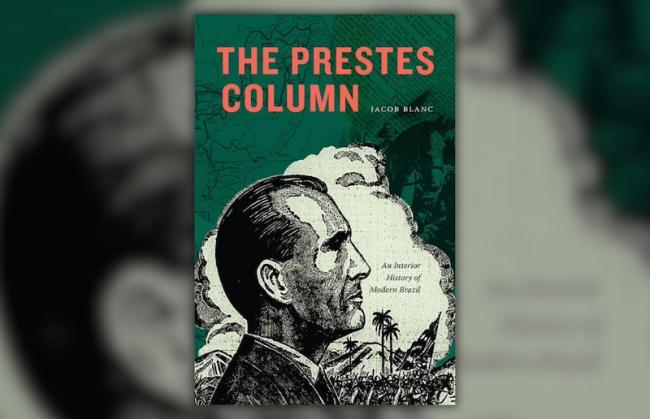
The Prestes Column, a Brazilian military rebel movement, crossed the De Contas River twice between April and July 1926. The column was the aftermath of a rebellion of army officers and soldiers who advocated for the industrialization of the country, a freer press, greater autonomy for judicial authorities, the institution of secret voting, and a system of universal public education. This movement morphed into a roving expedition that marched across the country for almost three years, from 1924 to 1927. It became one of the most famous events in modern Brazilian history and elevated leader Luís Carlos Prestes to a national hero known as the Knight of Hope. I am deeply connected to this river. Its water runs through my grandmother's backyard in Jequié, Bahia. I have seen this river rising many times to the top of a Seriguela tree, drying up during prolonged droughts, and filling up to the point of frightening the inhabitants of its banks. Until I read Jacob Blanc’s book, I never thought about that river—my river—being part of the trajectory of a potent national phenomenon that gradually came to symbolize an inclusionary vision of national progress.
Two opposing views of the rebels emerge from the Column experience. On one side, detractors focused on the violent and anarchic role of the rebel soldiers. On the other side, some see the symbolic legacy of the tenentista struggle as advocating for a more just and anti-oligarchic political system. Paying attention to the various political circumstances that modified motivations, arguments, and perspectives, Blanc provides a very lucid assessment of that experience, carefully avoiding further mythification or delegitimization.
Although the movement failed to overthrow the authoritarian government, the Prestes Column produced one of the most emblematic and charismatic Brazilian leftist leaders: Luís Carlos Prestes. To understand the construction of the mythology surrounding the Column of Rebel Soldiers and its main protagonist, Luís Carlos Prestes, the author explains two other phenomena: changes in the press and Brazilian journalism in the 1920s and the persistent imaginary of the interior of Brazil as the abstract place where all Brazilian authenticity springs.
The journalistic production on the Prestes Column in the country's interior reached the coast, an exotic reversal of the flow of major political decisions in the large coastal cities and only later spread to the interior. This reversal fascinated readers. Each time the rebel soldiers and lieutenants under the leadership of Luís Carlos Prestes set out on the march, new places, names, vegetation, and descriptions of populations were revealed, confronting the emerging urban middle class and literate elite with information they were unaware of about their own country. This was made possible by technical changes in newspapers and a context of censorship. Particularly for prominent daily newspapers in Rio de Janeiro and São Paulo, the newspaper adopted a new business structure that encouraged several innovations. To sell more copies, newspapers sought to meet and facilitate the demand for increasingly dramatic or mysterious stories.
Newspapers also began to publish serialized journalistic pieces in several parts. Previously, Brazilian newspapers tended to be a niche market oriented toward the literate upper classes and focused on politics and culture. However, industrialization in the early twentieth century helped create an emerging urban middle class, which in turn fostered a larger readership with new consumer interests. The rise of the rebels (later labeled as Tenentismo, or lieutenants) was linked to the advent of mass-market newspapers in the 1920s, whose fascination with interior news helped to galvanize sympathy, even if initially most of the press did not support the rebels.
The interior is a complex notion. It is a way of understanding an interior space as a physical landscape encompassing a wide range of topographies and populations and an imaginative landscape that can be adapted to various perspectives. This phenomenon develops in a country that is oriented towards the coast. This spatial and geographic phenomenon was also a result of the social contrast between the coast and the interior. Blanc shows how coastal elites have long viewed the interior regions and their populations as simultaneously backward (relative to a civilized coast) and dormant, a space of untapped potential waiting to be brought into the nation. The interior was part of the reason the dominant society lived along the coast. Still, the lack of a sustained presence in the interior made it attractive to literate coastal society. Thus, the interior was a space of “barbarism” and the true locus of national authenticity. It was, therefore, a powerful space for imagining and debating the country’s past, present, and future.
The “interior history” approach builds on ideas developed in Blanc’s first book, Before the Flood: The Itaipu Dam and the Visibility of Rural Brazil, especially the central rule of “the dialectic of land and legitimacy.” In the case of the Itaipu Dam, relationships with land encouraged people’s political and social aspirations while also determining the legitimacy of their aspirations. For Blanc, the term “legitimacy” reflects how one’s worldviews are considered valid or acceptable in the eyes of the dominant society. Thus, legitimacy can be claimed, and it can also be conferred. Blanc’s dialectic of land and legitimacy suggests that in the Brazilian countryside, one’s sense of legitimacy was fundamentally tied to a particular relationship with land. Here, it is also possible to see the tensions between interior and coast, rural and urban, and the status of authenticity.
Combining storytelling and analysis, Blanc finds new approaches and analyses of a topic that has already been extensively studied. For example, he uncovers the story of the women who followed the column of soldiers across Brazil. Despite the Column being associated with gaúcho culture and its specific type of Latin masculinity centered in the folk symbol figure of the skilled, brave, and unruly horseman, many women were part of the Column. The presence of women in the rebellion was a cause for alarm in Brazilian patrician society.
Known as vivandeiras, these women played crucial roles as fighters, nurses, cooks, and companions during the Column. Their contributions coincided with a growing women's movement that advocated for expanded employment opportunities and political rights, marking a significant step forward in the struggle for gender equality during a key period of the women’s movement in Brazil.
Similarly, one of the book’s highlights is the author’s recovery of the story of Tia Maria, the Black sorcerer who gave magical support protecting the rebel fighters from enemy’s bullets, bringing analysis of the racial aspects of this epic political process. The rumors about Tia Maria also reflected the racialized and gendered contours of mythmaking. Although the dominant narrative focused on the white men who comprised the rebel leadership, the presence of a Black woman like Tia Maria was used to label the Column as religious and racially deviant.
When the Column arrived in the state of Maranhão in 1925, Blanc brought the Xerentes Indigenous community into the forefront of his narrative. In one passage, Blanc shows why the encounter between them was remembered by the Xerente people as so positive. The rebels were fighting against militias that had abused Indigenous groups in the region. This interaction with the Xerente people was the first instance in which Brazilian Indigenous people made a significant appearance along the Column’s route. Many stories about them were later narrated in multiple rebel memoirs. By bringing perspectives on gender, race, and indigeneity, Blanc uncovers facets of the Column that escape previous narratives. This perspective allows Blanc to move comfortably from one scale to another, integrating the epic stories of rebel soldiers with micro-stories of lesser-known participants.
The book devotes a considerable section to analyzing the legacy of the Column, which is a significant exercise in analyzing a large volume of data, mainly newspapers and memoirs. Blanc divided the book into four periods. The first period begins in the immediate post-column period when Luís Carlos Prestes went into exile in 1927 to the Revolution of 1930. The revolution resulted in Getúlio Vargas taking power and introducing a substantial part of the Tenentismo political program. The second period is between 1930 and 1954, in which Blanc pays particular attention to the impasse between Prestes and Vargas. This was also a time of intense production of memoirs written by former rebels. The third period encompasses the thirtieth anniversary of the Column in 1954, the fiftieth anniversary in 1974 during the military dictatorship, and ends with Prestes’s death in 1990. In analyzing this period, Blanc demonstrates great erudition by bringing a wide range of cultural productions about the Prestes Column between the 1940s and 1980s. The fourth period addresses Prestes’s legacy on the eve of the twenty-first century, including reflections on the experience of the column in the “old” Brazil of the 1920s as a way of lamenting the changes brought about by the efforts to modernize the interior in the twentieth century.
This dynamic approach to the interior is an important contribution to understanding Brazil. Jacob Blanc’s book brings events, spaces, people, legacies, and spaces from the interior of Brazil into history, such as the river in my grandmother’s backyard. It provides us with a fundamental reminder that a substantial part of Brazilian history happened in the interior.
Caio Fernandes Barbosa has a PhD in History from the Federal University of Bahia.

